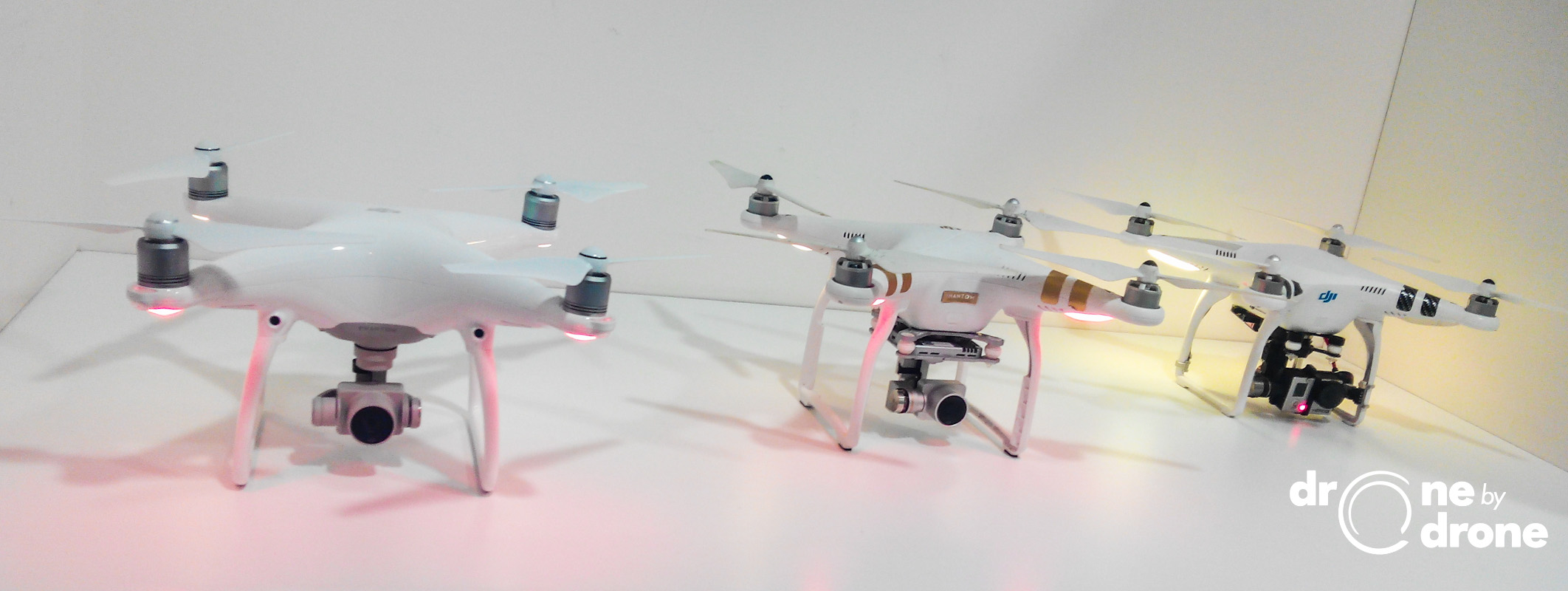The whole family.
Recently we presented the new DJI Phantom 4 newcomer to the market and to Spain.
We believe that it is worth making a small article to assess developments in the technology of drones in a short space of time, characteristic of the innovative sector in which we are immersed.
We will analyze the evolution of the most successful family of Chinese manufacturer DJI: The Phantom Family. From the DJI Phantom 2 to the recent DJI Phantom 4.
The DJI Phantom 2 was released just over two years ago, in early 2014. This drone led to the revolution in the sector at the user level, as it allowed to put a camera in the air with certain guarantees of security and stability, at a reasonable cost. The camera that carries the Phantom 2 is the GoPro, suspended thereto by a Zenmuse H3-3D stabilizer or gimbal, developed by the manufacturer. The development of the gimbal, with their stabilizer engines, allowed for stable shottings with limited means. From the controller of the pilot was not available command and camera control settings, although certain vertical movement or panning. The settings on the camera had to be made on the ground before taking off. In addition, the image provided by GoPro, could be sent by aditional devices to FPV screens for real-time viewing. It also had some ability to know some parameters of the aircraft with additional devices installed on the drone, as their performances and remaining battery capacity, though still very crude way.
The DJI Phantom 3 family and specifically the Phantom 3 Pro, was released about a year ago, in April 2015. Drone by Drone ordered the first units arrived in Spain and can test the innovative solutions provided in countless operations. It was a radical change from the Phantom 2 because it uses the control system of the DJI Inspire 1. The Phantom 3 Pro comes with a good quality and integrated 4K camera. The really revolutionary was the drone control system, since it was integrated into the DJI GO application for Android and IOS system. With IOS a number of problems they had are today already solved, but that's another story ... The DJI GO app integrates the drone, the controller, the camera and all imaginable flight parameters at a really powerful interface, intuitive and easy to handle, having at all times vital information for the pilot at a glance on the tablet or mobile phone attached to the controller. With this application the total configuration of the camera in flight can be changed, including the possibility of viewing photographic or video files obtained during the flight. It also has intelligent flight modes, following the controller of the pilot, flight route planning via waypoints, etc. The Phantom 3 Pro integrated system is a drone ready for flight, no more out of the box and connected via the application via a mobile device. A great revolution, priced content.
The new Phantom 4 fresh from the market, is the evolution of Phantom 3 Pro , keeping the basic flight configuration and control, with improved engines. It Still uses the DJI GO application for total control and DJI has included new intelligent flight modes, such as tracking moving targets using image recognition. The most notable new feature of the Phantom 4 is the detection and avoidance of obstacles. This system allows to increase the flight safety and opens up a very promising horizon for integration into the controlled air space and between everyday life. The flight autonomy of the Phantom family is gradually increasing with the emergence of new models reaching up to 28 min for the Phantom 4. The Phantom 4 is the future that becomes present.





